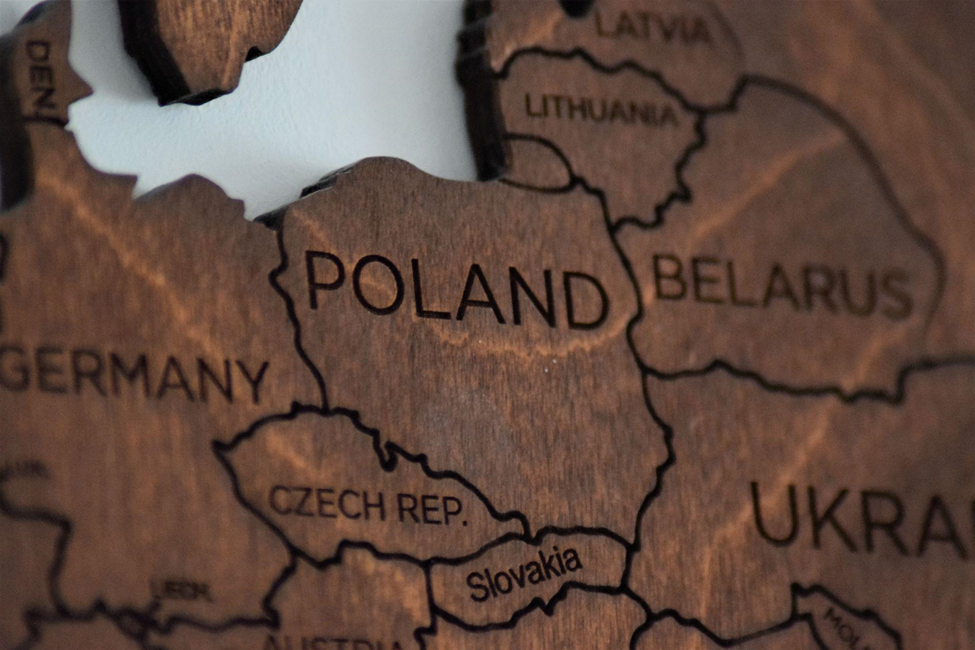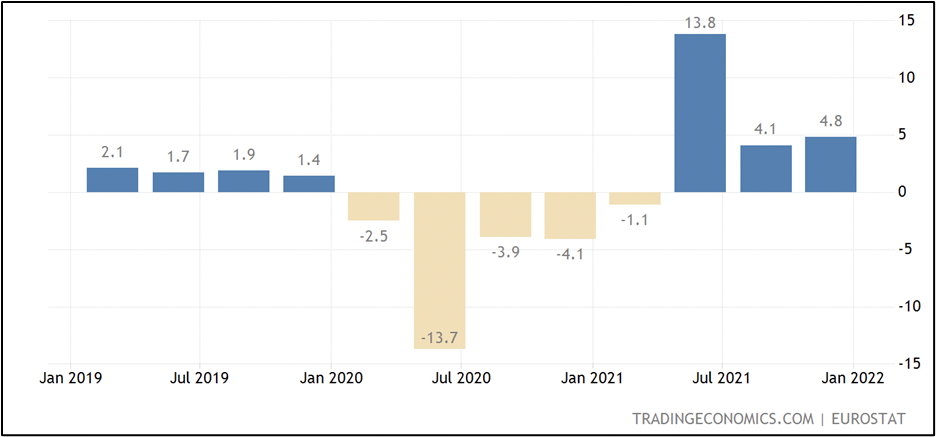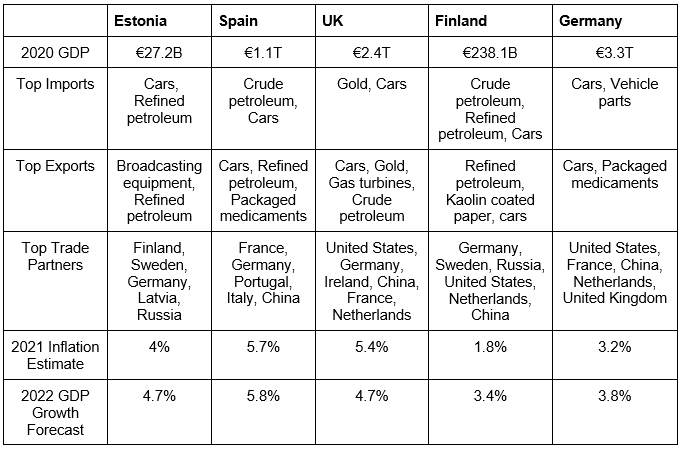There are 44 countries in Europe, 11 of which are also the top 25 largest economies globally. What drives these booming economies? What similarities do they share, and what sets them apart? How does Luxembourg—Europe’s wealthiest nation—have a GDP per capita that’s greater than 30 times that of Moldova, the continent’s poorest country? To better understand the economic picture in Europe as a whole, we’re going to break down some of the significant factors contributing to the financial state of a few key European economies.

Local currency
With 19 countries using the euro as their official currency, we would be remiss not to delve into the performance of the second most-traded currency in the world. Despite rapidly-rising inflation in late 2021, the European Central Bank (ECB) seems to be opposed to rate hikes in 2022. In response, investors seek shelter in other currencies, sending the EUR/USD exchange rate to 1.11, its lowest in 18 months. In Europe, many wealthier countries share a currency in the euro (notable exceptions include the UK, Switzerland, Sweden, Norway, and Denmark) thanks to the birth of the eurozone in 1999.
Imports
Europe’s top imports consist of the following:
- Computer and electronic products
- Motor vehicles and trucks
- Crude petroleum and natural gas
- Chemicals
- Machinery and equipment
- Pharmaceutical products and medicaments
- Electrical equipment
Germany is Europe’s largest importer by far, spending over 1 trillion euros annually and accounting for nearly 20% of the EU’s total imports. 12% of Germany’s purchases come from China, making it the top importer of goods into Germany. Other significant importers to Germany include the Netherlands, United States, Poland, France, and Italy.
While Germany imports almost double as much as any other European country, the UK, Netherlands, and France are also sizable importers, importing 500 – 700 billion euros worth of goods annually. The UK is a bit unique in that its largest import is gold (the UK and Switzerland are the world’s top two importers of gold), with the precious metal accounting for almost 10% of the UK’s imports. The UK is also a big buyer of cars, which make up over 7% of imports.
Several European countries heavily rely on imports to provide cars and petroleum. Petroleum and cars are the top two import items for several European countries, such as Estonia, Spain, Italy, Poland, Norway, and Finland.
Exports

The exports of Europe are led by machinery and equipment, pharmaceutical products, and vehicles. Germany, the EU’s largest exporter, is a world leader in exporting cars and vehicle parts. Though less well known for their ability to produce cars, the UK and Spain are among the top-10 automobile-exporting countries globally. At the same time, the additional representation from Europe in the top-15 can be found in Slovakia, France, Czechia, Italy, and Sweden.
Both the United Kingdom and Germany play a key role in Europe’s exports of machinery and equipment. Pharmaceutical products also make up for a considerable portion of European exports. Of the top-10 largest exporters of pharmaceuticals globally, eight are from Europe (Germany, Switzerland, Ireland, Belgium, France, UK, Italy, Netherlands), generating hundreds of billions of euros for the European economy.
Major industries
The vast majority (~75%) of the EU economy consists of services, followed by manufacturing (~24%) and agriculture (~1.5%). Europe is anchored by the financial services industry, primarily in London, Zurich, Frankfurt, and Luxembourg City. Travel and tourism is also a strong industry in Europe. France, Spain, Italy, Germany, and the UK are among the 10 most popular tourist destinations worldwide.
The strength of the European manufacturing industry should come as no surprise, given Europe’s exports of vehicles, machinery, and pharmaceuticals. European industry also includes manufacturing plastics, medical equipment, and chemicals.
Finally, though Europe isn’t known for its oil and gas reserves, its oil and gas companies generate more revenue than any other industry. Shell and BP occupy the top two positions, doing hundreds of billions of euros worth of business annually.
Largest Employers

England’s National Health Service (NHS) is hands-down the largest employer in Europe, employing a whopping 1.3 million people.
As the largest economy in Europe, Germany is also home to many of the largest employers on the continent. Employing over 660,000 individuals, Volkswagen is Germany’s top employer. Other leading German employers include postal services company Deutsche Post DHL (~400,000 employees), the engineering & technology company Bosch (~395,000 employees), and the supermarket chain Edeka Zentrale (~381,000 employees).
In the UK, Compass Group, the largest food services corporation globally, has more than 548,000 employees. Just west of the UK in Ireland, Accenture (a well-known IT and consulting firm) has grown significantly and, as of 2021, employs over 674,000 people. Ireland, the fastest-growing economy in the EU, managed to withstand the pandemic and post an impressive 6% increase in GDP in 2020.
How is the European economy performing today?
After experiencing the pain of declining GDP in 2020 due to the COVID-19 outbreak, the EU economy roared back to life in 2021 with an average national growth rate of 5%. Following a decade of steady annual GDP growth, EU GDP in 2020 was roughly €13.39 trillion, down from €14.06 trillion in 2019. In 2021, the estimated GDP for all EU countries combined was in the range of €15 trillion, led by Germany’s €3.75 trillion economy. Though not in the EU in early 2020, the UK boasts Europe’s second-largest economy with a GDP of about €2.75 trillion. In France, after GDP declined nearly 8% in 2020, the economy quickly reversed course and posted gains of 7% in 2021–its most significant increase in over 50 years.

In terms of economic growth, the Irish again led the pack in 2021, forecasting an expected 14.6% increase. Other countries that enjoyed expanding economies in 2021 are concentrated in Central and Eastern Europe, including Estonia (9%), Croatia (8.1%), Hungary (7.4%), Romania (7%), and Slovenia (6.4%).
Germany lagged far behind the EU average despite its longtime status as Europe’s largest economy, growing by just 2.7% in 2021. Another EU laggard in 2021 was Finland, whose economic growth fared little better than Germany’s, expanding by 3.5%.
With 2022 underway, the economic focus seems to be centered on inflation rather than economic expansion. Inflation in the Euro area was up 5% in December, a staggering figure mainly due to energy prices rising more than 25%. Economic forecasts for the EU predict a 4.3% increase in 2022, but inflation forecasts seem to be a point of contention. The ECB is confident inflation will fall below 2% by the end of 2022, with others predicting a 2.7% jump.
To round off our breakdown, here’s a table showing key facts about these countries’ economies:
